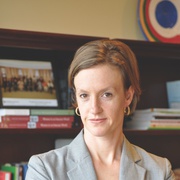
A dinghy full of migrants approaches the coast of the Greek island of Lesbos after crossing from Turkey to Greece as a Syrian woman who just arrive holds her child,Thursday, Sept. 10, 2015. AP Photo/Petros Giannakouris
Women Are On Front Lines Of Every Battle Zone, But Not In The Way You Think
Through four years of horrendous civil war, women have handled local ceasefires, human rights abuses, opened temporary schools, and exposed local officials.
In April 2011, a crowd of 2,000 women and children blocked a highway in northwestern Syria to demand that government officials release hundreds of men who had been rounded up in neighboring villages. The protest succeeded and the men came home. Through four years of horrendous civil war, women have negotiated local ceasefires, including a recent 20-day truce in a violence-ravaged Damascus suburb. Women have documented human rights abuses, opened temporary schools, and exposed local officials who failed to hand out donated food and medical supplies.
The value of such work has long been recognized — at least in proclamations and plans. Fifteen years ago this month, the United Nations Security Council declared that women need to be included as decision-makers on issues of peace and security. The nascent promise in this consensus, embodied in UNSC Resolution 1325, is most visible in the world’s deadliest conflicts, from Syria to Afghanistan and South Sudan. But the impact is greater than just the hotspots: So far, 55 countries, including the United States, have adopted national action plans to guide greater involvement of women in preventing and resolving conflicts, and to assure that peace is community-rooted and sustained.
The principle behind Resolution 1325 is that women must no longer be seen simply as victims in conflict; they have to be involved in shaping the solutions. This can be dangerous and unwelcome; in varying degrees, most societies are accustomed to thinking of security as a male domain. But that ignores the advantages women bring to the table, including their skill in building bridges across dividing lines, down to the most local of levels.
In Afghanistan’s Herat province, for example, a soft-spoken woman named Amina forged personal relationships with individuals, including wives of Taliban insurgents, who attended her workshop on women’s role in the community. After Amina heard that her relative’s teen-aged son had been kidnapped by the husbands of these women, she persuaded the wives to get involved. Her relationship paid off — after 13 days in captivity, the boy was set free.
Over the past 15 years, many of those who have witnessed the positive results and broader dialogues that emerge when women are included have begun to champion change, to include all stakeholders in peace and security work. Afghan President Ashraf Ghani is one such champion. He told the U.S. Congress: “No country in the modern world can be self-reliant with half of its population locked away uneducated and unable to contribute energy, creativity and national development.” And he has proved willing to invest political capital. Leaders of Afghanistan’s civil society organizations and officials from 15 different ministries spent three years hashing out details of the country’s plan to get women into higher-impact positions that shape security decisions.
The surge in terrorism and violent extremism in the last two decades makes it even more important to involve all those with a stake in a country’s well-being. One important strategy for capitalizing on women’s talent is promoting their recruitment and advancement in police forces worldwide. These units, because of their permanent local presence and knowledge, are better-placed than the military to counter violent extremism over the long-term. Recruiting women, who frequently have wide personal networks and go places that males cannot, yields broader intelligence. Women police build trust with local communities; female civilians are more likely to report gender-based violence to women officers. Policewomen are also more likely to deescalate tensions and less likely to use excessive force. The U.S. Congress has recognized the desperate need for recruiting more women in the Afghan National Security Forces, for example, by appropriating $50 million over the last two years.
Progress is still too slow in embracing “inclusive security.” Between 1992 and 2011, women made up just 2% of mediators and 9% of negotiators in official peace talks worldwide. Yet, social science and business researchers overwhelmingly agree that, as a group, women show particular strengths when it comes to compromise and collaboration; in other words, we’re missing out. Similarly, peace agreements are more likely to last at least 15 years if women participate meaningfully in their creation. When women are absent, there’s a 25 to 50 percent chance that the peace will fail within five years.
The facts are clear: Involving all of a society in peace and security, not just half the population, leads to better results.
At the Newseum in Washington Thursday, the Institute for Inclusive Security and the U.S. Department of State will bring together some 500 policymakers and activists to look back at progress over the past 15 years toward this inclusive approach and assess obstacles to achieving greater gains in the next 15 years. Dozens of women leaders from around the world will rue the slow headway even as they celebrate the advances.
Whether on the front lines in Syria, in rural parts of Afghanistan, in police forces in Pakistan, or at peace tables in Havana where negotiators just thrashed out a deal to end decades of civil war in Colombia, women are contributing to security – and we must knock down the barriers that hinder them from doing even more.
NEXT STORY: Turkey’s 10-Sided War With Itself
